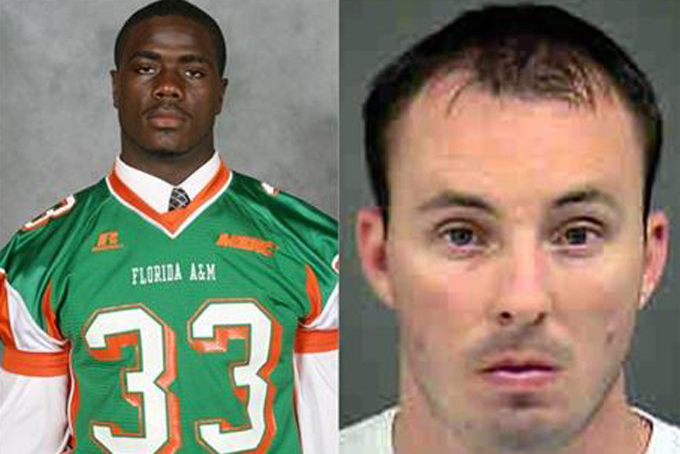
This combination of undated file photos provided by Florida A&M University and the Charlotte-Mecklenburg Police shows Jonathan Ferrell, left, and police officer Randall Kerrick. (AP Photo/Florida A&M University, Charlotte-Mecklenburg Police)
by Mitch Weiss
Associated Press Writer
CHARLOTTE, N.C. (AP) — A toxicology report released Friday shows the blood-alcohol level for an unarmed man fatally shot by a Charlotte police officer was below the legal limit.
The attorney for the family of Jonathan Ferrell says the report confirms that the 24-year-old former Florida A&M football player wasn’t drunk the night of the September shooting. The report also shows there were no illegal drugs in his system.
Chris Chestnut said Ferrell was just trying to get help after he was injured in a car accident.
“This confirms everything we’ve been saying since the day that Jonathan was killed: That this was an All-American guy who gave a friend a ride home and was just trying to get home himself when he had a car accident. And when he was runs to the officer for help, the officer shoots him 10 times,” Chestnut told The Associated Press.
Charlotte-Mecklenburg Officer Randall Kerrick is charged with voluntary manslaughter in the racially charged case in North Carolina’s largest city. Kerrick, 27, is white; Ferrell is black.
Civil rights leaders have praised the police for quickly filing charges, and have questioned whether race played a role in the shooting.
But police groups have called the department’s move a rush to judgment. They say most departments, including Charlotte, usually take weeks — sometimes months — to complete an investigation of a police shooting, and then decide whether to file charges.
The North Carolina attorney general’s office is now handling the case.
The state medical examiner’s office toxicology report showed that Ferrell’s blood-alcohol level was 0.06; the threshold for drunken driving in North Carolina is 0.08.
Ferrell’s autopsy, also released Friday, showed he had been shot 10 times. The official cause of death: Multiple gunshot wounds to the chest. Kerrick fired 12 shots, police have said.
Police Chief Rodney Monroe has said that while Ferrell did advance on Kerrick, the shooting was excessive. Monroe said the department’s investigation showed the officer didn’t have a lawful right to discharge his weapon. Kerrick’s attorneys said the shooting was justified because Ferrell didn’t obey verbal commands to stop.
The toxicology report and autopsy were released one day after a Mecklenburg County judge blocked the release of a dashboard video showing the shooting death because he said it would be prejudicial to the case.
Chestnut said Monroe promised Ferrell’s family that he would release the tape. Chestnut and family have watched the tape and say it shows that Ferrell posed no threat to officers.
The attorney questioned the timing of the release of Ferrell’s toxicology and autopsy reports, and other information related to Ferrell, but not the officer. They include a 911 tape, released last month, in which a woman keeps telling police over and over to hurry to her house because a man was breaking in.
Ferrell moved to Charlotte about a year ago with his fiancee when she took a new job. He was attending Johnson C. Smith University, while working two jobs. His family said he wanted to be an automotive engineer. He had no criminal record.
His encounter with police was set in motion at 2:30 a.m. Sept. 14. He had just dropped a friend off, when his car ran off the entrance road to a suburban neighborhood. After crashing his car into trees, Ferrell kicked out the back window and knocked on the door of a nearby house seeking help. The woman inside called 911, thinking he was trying to break into her home.
Kerrick and two other officers responded to the call. They found Ferrell on a road that leads only to the neighborhood’s pool. Ferrell ran toward the officers, who tried to stop him with a Taser. Police said he continued to run toward them and Kerrick opened fire.
